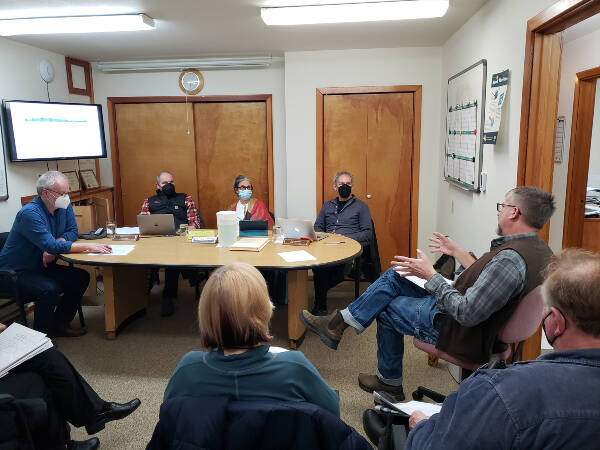A standing-room-only group gathered in Water District 19’s small meeting room last week to offer up suggestions for how the district could issue new water shares, should commissioners vote to end the district’s 26-year-old moratorium next month.
No one spoke in opposition to the district issuing new water shares during about 90 minutes of lively discussion at the Jan. 10 meeting.
Commissioners said they expect to vote at their next meeting to formally end a moratorium first put in place in 1996. The meeting will be held at 6 p.m. Thursday, Feb. 16.
“We’d like to hold the (water share) allocation event this spring,” Seth Zuckerman, who chairs the three-member commission, told the group.
The meeting began with a 15-minute presentation by Commissioner Mike Weller, explaining the history of the moratorium and the district’s current assessment of its water availability.
The district’s recently approved water system plan, submitted to the state Department of Health last year, assumes the district would issue 14 new shares a year, as well as begin providing water to 10 zero-use customers — people who already have a share but haven’t begun using it — Weller said. The district has about 200 zero-use customers. Also factored into the planning scenario is the amount of water needed for a record-hot day “and a really large fire,” he added.
The water system plan was based on data from 2010 to 2016, Weller told the group. After the state asked for updated figures, John Martinak, the district’s general manager, analyzed usage over the past six years. “Our numbers are tracking,” Weller said. “That gave us confidence that our plan is based in reality.”
During the discussion that followed, most seemed eager to see the moratorium end. One person mentioned that his wife had been trying to get on the waiting list for water shares — which closed in 2002 — for about 20 years. Another islander, Bruce Kirschner, described short-platting his property years ago with an eye to developing it — “that was my retirement,” he said — but was unable to do so because of the moratorium.
Others talked about how the district should manage selling water shares in a post-moratorium world. Some suggested that the district offer shares via an auction, rather than a flat fee, to raise capital for the often cash-strapped district. Others suggested a process that prioritized those who seek shares year after year, rather than a random lottery each time the district has shares to issue. Still others expressed concern about equity and affordable housing and urged the district to work with others in King County to develop denser housing in Vashon town.
“It would be really lovely to see the government and the water district work in harmony,” said Marie Browne. “Denser development … could be supported if those water shares could be kept uptown for housing.”
But Zuckerman cautioned against a share-distribution plan guided by the commissioners’ beliefs about what’s best for the island. It would be hard to enforce policies that encourage affordable housing, he said. Five shares could be sold to Vashon HouseHold, for instance, only to have the nonprofit housing developer change course and sell the property to an individual with no such plan. Or what if all three commissioners wanted to see a water park on Vashon and awarded several shares to try to make that happen, he posited.
“You can imagine you wouldn’t want to give the commission that kind of power,” he said.
Still, he said, he could envision a scenario where people who had water shares to sell back to the district did so with a stipulation that those shares go to affordable housing. “You’ve given us a lot to think about,” he said.
The commissioners were also asked about the Beall well — about a decade ago, it was found to have nearly four times the amount of arsenic allowed under government standards for domestic drinking supplies — and whether issuing more shares could mean bringing more arsenic into District 19’s water supply.
Water from the Beall well is not fed into the system, said Armin Wahanik, District 19’s lead operator, clarifying in a phone call, after the meeting, that this has been the case for the past decade.
Zuckerman said that during the peak usage envisioned in their plan – a hot day on Vashon along with a large structure fire — “we’d be running the Beall well.” But because its water is diluted with treated water from Beall Creek, arsenic levels would remain below the legal maximum, he said.
Another islander, Diane Emerson, asked about how issuing new shares would affect service quality issues on the west end of Bank Road. Noting she was asking the question on behalf of someone who could not attend, she said that part of the district’s system has had “issues with quality, quantity and pressure.”
“If we have five more customers, that would not degrade the water that’s available,” Zuckerman answered. “What’s in the way is having a good pipe.”
After the meeting, the district’s commissioners said they hope to vote on resolutions that will both end the moratorium and establish a fair system for awarding shares at their meeting in February.
“We still have a lot to figure out,” said Commissioner Robin Pfohman.
— Leslie Brown is a former editor of The Beachcomber.
Corrections: In the print edition of this article, islander Bill Kirschner’s name was misspelled and is corrected here. Additionally, the article mistakenly quoted Armin Wahanik, District 19’s lead operator, as saying that water from the Beall well “has never been fed into the system.” The article is corrected here to reflect Wahanik’s statement that water from the well is never fed into the system. We strive for accuracy and regret the errors.


